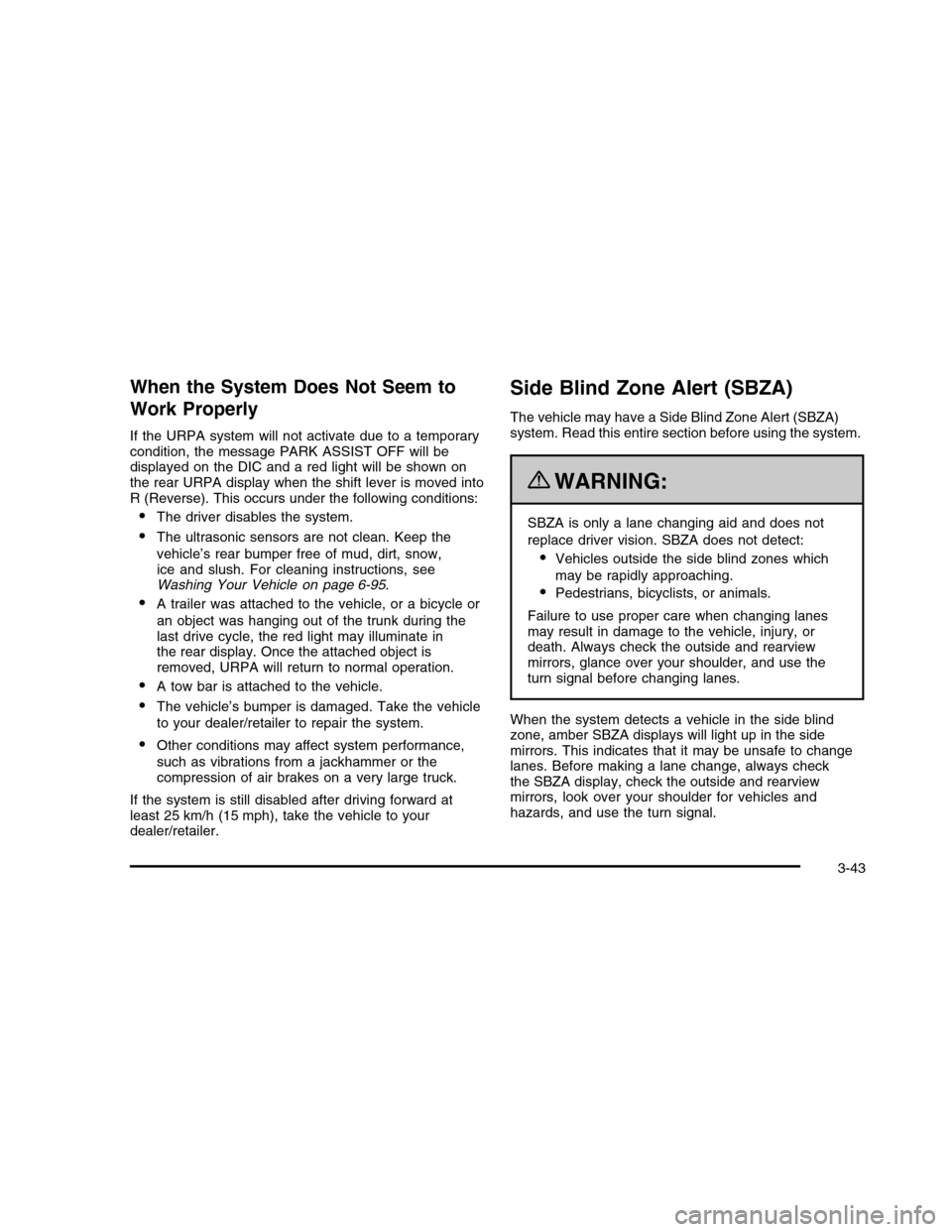sensor CADILLAC DTS 2010 1.G Owners Manual
[x] Cancel search | Manufacturer: CADILLAC, Model Year: 2010, Model line: DTS, Model: CADILLAC DTS 2010 1.GPages: 480, PDF Size: 17.56 MB
Page 29 of 480

Roadside Service
U.S. or Canada:1-800-882-1112
TTY Users:1-888-889-2438
As the owner of a new Cadillac, you are automaticallyenrolled in the Roadside Service program which isavailable 24 hours a day, 365 days a year.
Roadside Service and OnStar
If you have a current OnStar subscription, press theOnStar button and the current GPS location will be sentto an OnStar Advisor who will assess your problem,contact Roadside Service, and relay exact location toget you the help you need.
Online Owner Center
The Online Owner Center is a complimentary servicethat includes online service reminders, vehiclemaintenance tips, online owner manual, specialprivileges and more.
Sign up today at:www.gmownercenter.com/cadillac(U.S.) orwww.gm.ca(Canada).
OnStar®
OnStar®uses several innovative technologies and liveadvisors to provide a wide range of safety, security,navigation, diagnostics, and calling services.
Automatic Crash Response
In a crash, built in sensors can automatically alert anOnStar advisor who is immediately connected tothe vehicle to see if you need help.
1-23
Page 95 of 480

When Should an Airbag Inflate?
Frontal airbags are designed to inflate in moderate tosevere frontal or near-frontal crashes to help reduce thepotential for severe injuries mainly to the driver’s orright front passenger’s head and chest. However, theyare only designed to inflate if the impact exceeds apredetermined deployment threshold. Deploymentthresholds are used to predict how severe a crash islikely to be in time for the airbags to inflate andhelp restrain the occupants.
Whether your frontal airbags will or should deploy is notbased on how fast your vehicle is traveling. It dependslargely on what you hit, the direction of the impact,and how quickly your vehicle slows down.
Frontal airbags may inflate at different crash speeds.For example:
•If the vehicle hits a stationary object, the airbags
could inflate at a different crash speed than if thevehicle hits a moving object.
•If the vehicle hits an object that deforms, the
airbags could inflate at a different crash speed thanif the vehicle hits an object that does not deform.
•If the vehicle hits a narrow object (like a pole), the
airbags could inflate at a different crash speedthan if the vehicle hits a wide object (like a wall).
•If the vehicle goes into an object at an angle, the
airbags could inflate at a different crash speedthan if the vehicle goes straight into the object.
Thresholds can also vary with specific vehicle design.
Frontal airbags are not intended to inflate during vehiclerollovers, rear impacts, or in many side impacts.
Your vehicle has a seat position sensor which enablesthe sensing system to monitor the position of the rightfront passenger’s seat. The passenger seat positionsensor and passenger safety belt buckle switch provideinformation that is used to determine if the airbags shoulddeploy at a reduced level or at full deployment.
In addition, your vehicle has a dual-stage driver airbag.Dual-stage airbags adjust the restraint according tocrash severity. Your vehicle has electronic frontalsensors, which help the sensing system distinguishbetween a moderate frontal impact and a more severefrontal impact. For moderate frontal impacts, dual-stageairbags inflate at a level less than full deployment.For more severe frontal impacts, full deployment occurs.
2-63
Page 96 of 480

Your vehicle also has a dual-depth passenger airbagthat adjusts the restraint according to crash severity,seat location, and safety belt status using electronicfrontal sensor(s) and other special sensors which enablethe sensing system to monitor the position of the frontpassenger seat. The passenger airbag inflates to areduced depth when the passenger seat is in a forwardposition. For more rearward front seating positions,the passenger airbag may inflate to an increased depth(a full deployment), based on safety belt status andthe crash severity measured early in the event. (Alwayswear your safety belt, even with frontal airbags.)
Your vehicle has seat-mounted side impact airbags.Your vehicle may have roof-rail airbags. SeeAirbagSystem on page 2-58. Seat-mounted side impact androof-rail airbags are intended to inflate in moderateto severe side crashes. Seat-mounted side impact androof-rail airbags will inflate if the crash severity isabove the system’s designed threshold level. Thethreshold level can vary with specific vehicle design.
Seat-mounted side impact and roof-rail airbags arenot intended to inflate in frontal impacts, near-frontalimpacts, rollovers, or rear impacts. A seat-mounted sideimpact airbag is intended to deploy on the side of thevehicle that is struck. Both roof-rail airbags willdeploy when either side of the vehicle is struck.
In any particular crash, no one can say whether anairbag should have inflated simply because of thedamage to a vehicle or because of what the repair costswere. For frontal airbags, inflation is determined bywhat the vehicle hits, the angle of the impact, and howquickly the vehicle slows down. For seat-mountedside impact and roof-rail airbags, deployment isdetermined by the location and severity of theside impact.
2-64
Page 100 of 480

When the system check is complete, either the wordON or OFF, or the symbol for on or off, will be visible.SeePassenger Airbag Status Indicator on page 4-51.
The passenger sensing system turns off the rightfront passenger frontal airbag and seat-mounted sideimpact airbag under certain conditions. The driverairbags and the roof-rail airbags are not affected by thepassenger sensing system.
The passenger sensing system works with sensors thatare part of the right front passenger seat. The sensorsare designed to detect the presence of a properly-seatedoccupant and determine if the right front passengerfrontal airbag and seat-mounted side impact airbagshould be enabled (may inflate) or not.
According to accident statistics, children are safer whenproperly secured in a rear seat in the correct childrestraint for their weight and size.
We recommend that children be secured in a rear seat,including: an infant or a child riding in a rear-facingchild restraint; a child riding in a forward-facing childseat; an older child riding in a booster seat; and children,who are large enough, using safety belts.
A label on the sun visor says, “Never put a rear-facingchild seat in the front.” This is because the risk tothe rear-facing child is so great, if the airbag deploys.
{WARNING:
A child in a rear-facing child restraint can be
seriously injured or killed if the right front passenger
airbag inflates. This is because the back of the
rear-facing child restraint would be very close to the
inflating airbag. A child in a forward-facing child
restraint can be seriously injured or killed if the right
front passenger airbag inflates and the passenger
seat is in a forward position.
Even if the passenger sensing system has turned
off the right front passenger frontal airbag and
seat-mounted side impact airbag (if equipped), no
system is fail-safe. No one can guarantee that an
airbag will not deploy under some unusual
circumstance, even though the airbag(s) are off.
Secure rear-facing child restraints in a rear seat,
even if the airbag(s) are off. If you secure a
forward-facing child restraint in the right front seat,
always move the front passenger seat as far back
as it will go. It is better to secure the child restraint in
a rear seat.
2-68
Page 105 of 480

Adding Equipment to Your
Airbag-Equipped Vehicle
Q:Is there anything I might add to or changeabout the vehicle that could keep the airbagsfrom working properly?
A:Yes. If you add things that change your vehicle’s
frame, bumper system, height, front end or side
sheet metal, they may keep the airbag system from
working properly. Changing or moving any parts
of the front seats, safety belts, the airbag sensing
and diagnostic module, steering wheel, instrument
panel, roof-rail airbag modules, ceiling headliner
or pillar garnish trim, overhead console, front
sensors, side impact sensors, or airbag wiring can
affect the operation of the airbag system.
In addition, your vehicle has a passenger sensing
system for the right front passenger’s position,
which includes sensors that are part of the
passenger’s seat. The passenger sensing system
may not operate properly if the original seat
trim is replaced with non-GM covers, upholstery or
trim, or with GM covers, upholstery or trim
designed for a different vehicle. Any object, such as
an aftermarket seat heater or a comfort enhancing
pad or device, installed under or on top of the
seat fabric, could also interfere with the operation of
the passenger sensing system. This could either
prevent proper deployment of the passenger
airbag(s) or prevent the passenger sensing system
from properly turning off the passenger airbag(s).
SeePassenger Sensing System on page 2-67.
If you have any questions about this, you should
contact Customer Assistance before you modify
your vehicle. The phone numbers and addresses for
Customer Assistance are in Step Two of the
Customer Satisfaction Procedure in this manual.
SeeCustomer Satisfaction Procedure on page 8-2.
Q:Because I have a disability, I have to getmy vehicle modified. How can I find out whetherthis will affect my airbag system?
A:If you have questions, call Customer Assistance.
The phone numbers and addresses for Customer
Assistance are in Step Two of the Customer
Satisfaction Procedure in this manual. See
Customer Satisfaction Procedure on page 8-2.
In addition, your dealer/retailer and the service manualhave information about the location of the airbagsensors, sensing and diagnostic module andairbag wiring.
2-73
Page 148 of 480

Object Detection Systems
Ultrasonic Front and Rear Parking
Assist (UFRPA)
For vehicles with the Ultrasonic Front and Rear ParkingAssist (UFRPA) system, it operates at speeds lessthan 8 km/h (5mph), and assists the driver with parkingand avoiding objects. It can determine how closeobjects are to the front bumper, up to 1.2 m (4 ft.) infront of the vehicle and the rear bumper, up to2.5 m (8 ft.) behind the vehicle. The distance sensorsare located on the front and rear bumper.
{WARNING:
The Ultrasonic Front and Rear Park Assist
(UFRPA) system does not replace driver vision.
It cannot detect:
•objects that are below the bumper,
underneath the vehicle, or if they are tooclose or far from the vehicle
•children, pedestrians, bicyclists, or pets.
If you do not use proper care before movingforward and while backing; vehicle damage, injury,or death could occur. Even with UFRPA, alwayscheck in front of the vehicle before moving forwardand behind the vehicle before backing up. Whilemoving forward and backing, be sure to look forobjects and check the vehicle’s mirrors.
3-40
Page 151 of 480

When the System Does Not Seem to
Work Properly
If the URPA system will not activate due to a temporarycondition, the message PARK ASSIST OFF will bedisplayed on the DIC and a red light will be shown onthe rear URPA display when the shift lever is moved intoR (Reverse). This occurs under the following conditions:
•The driver disables the system.
•The ultrasonic sensors are not clean. Keep the
vehicle’s rear bumper free of mud, dirt, snow,ice and slush. For cleaning instructions, seeWashing Your Vehicle on page 6-95.
•A trailer was attached to the vehicle, or a bicycle or
an object was hanging out of the trunk during thelast drive cycle, the red light may illuminate inthe rear display. Once the attached object isremoved, URPA will return to normal operation.
•A tow bar is attached to the vehicle.
•The vehicle’s bumper is damaged. Take the vehicle
to your dealer/retailer to repair the system.
•Other conditions may affect system performance,
such as vibrations from a jackhammer or thecompression of air brakes on a very large truck.
If the system is still disabled after driving forward atleast 25 km/h (15 mph), take the vehicle to yourdealer/retailer.
Side Blind Zone Alert (SBZA)
The vehicle may have a Side Blind Zone Alert (SBZA)system. Read this entire section before using the system.
{WARNING:
SBZA is only a lane changing aid and does not
replace driver vision. SBZA does not detect:
•Vehicles outside the side blind zones which
may be rapidly approaching.
•Pedestrians, bicyclists, or animals.
Failure to use proper care when changing lanesmay result in damage to the vehicle, injury, ordeath. Always check the outside and rearviewmirrors, glance over your shoulder, and use theturn signal before changing lanes.
When the system detects a vehicle in the side blindzone, amber SBZA displays will light up in the sidemirrors. This indicates that it may be unsafe to changelanes. Before making a lane change, always checkthe SBZA display, check the outside and rearviewmirrors, look over your shoulder for vehicles andhazards, and use the turn signal.
3-43
Page 152 of 480

SBZA Detection Zones
The SBZA sensor covers a zone of approximately onelane over from both sides of the vehicle, 3.5 m (11 ft).This zone starts at each side mirror and goes backapproximately 5 m (16 ft). The height of the zone isapproximately between 0.5 m (1.5 ft) and 2.0 m (6 ft) offthe ground.
The SBZA detection zones do not change if the vehicleis towing a trailer. So be extra careful when changinglanes while towing a trailer.
How the System Works
When the vehicle is started, both outside mirror displayswill briefly come on to indicate that the system isoperating. While driving forward, the left or right sidemirror SBZA display will light up if a vehicle is detected inthat blind zone. If you activate a turn signal and a vehiclehas been detected on the same side, the SBZA displaywill flash to give you extra warning not to change lanes.
SBZA displays do not come on while the vehicle isapproaching or passing other vehicles. At speedsgreater then 20 mph (32 km/h), SBZA displays maycome on when a vehicle you have passed remains in ordrops back into the detection zone.
SBZA can be disabled through the Driver InformationCenter (DIC). SeeDriver Information Center (DIC)on page 4-61for more information. If the SBZAis disabled by the driver, the SBZA mirror displays willnot light up during normal driving.
Left Side Mirror DisplayRight Side MirrorDisplay
3-44
Page 153 of 480

When the System Does Not Seem To Work
Properly
Occasional missed alerts can occur under normalcircumstances and will increase in wet conditions. Thesystem does not need to be serviced due to anoccasional missed alert. The number of missed alertswill increase with increased rainfall or road spray.
If the SBZA displays do not light up when the system ison and vehicles are in the blind zone, the systemmay need service. Take the vehicle to yourdealer/retailer.
SBZA is designed to ignore stationary objects; however,the system may occasionally light up due to guard rails,signs, trees, shrubs, and other stationary objects. This isnormal system operation, the vehicle does not needservice.
SBZA does not operate when the left or right cornersof the rear bumper are covered with mud, dirt, snow, ice,slush, or in heavy rainstorms. For cleaning instructions,seeWashing Your Vehicle on page 6-95. If the DICstill displays the SIDE BLIND ZONE SYSTEMUNAVAILABLE message after cleaning the bumper, seeyour dealer/retailer.
The SBZA displays may remain on if a trailer is attachedto the vehicle, or a bicycle or object is extending outto either side of the vehicle.
When SBZA is disabled for any reason other than thedriver turning it off, the driver will not be able to turnSBZA back on using the DIC. The SIDE BLIND ZONEALERT ON option will not be selectable if theconditions for normal system operation are not met.Until normal operating conditions for SBZA are met, youshould not rely upon SBZA while driving.
SBZA Error Messages
The following messages may appear in the DIC:
SIDE BLIND ZONE ALERT SYSTEM OFF:Thismessage indicates that the driver has turned thesystem off.
SIDE BLIND ZONE SYSTEM UNAVAILABLE:Thismessage indicates that the SBZA system is disabledbecause the sensor is blocked and cannot detectvehicles in the blind zone. The sensor may be blockedby mud, dirt, snow, ice, slush, or even heavyrainstorms. This message may also activate duringheavy rain or due to road spray. The vehicle does notneed service. For cleaning, seeWashing YourVehicle on page 6-95.
SERVICE SIDE BLIND ZONE ALERT SYSTEM:If thismessage appears, both SBZA displays will remain onindicating there is a problem with the SBZA system.If these displays remain on after continued driving, thesystem needs service. Take the vehicle to yourdealer/retailer.
3-45
Page 176 of 480

Flash-to-Pass
This feature lets you use the high-beam headlamps tosignal the driver in front of you that you want to pass.
The flash-to-pass feature will only work with theheadlamps on. It does not work with Daytime RunningLamps (DRL).
Pull and hold the turn signal lever toward you to use.
If the headlamps are on low beam, pulling the turn signaltowards you will flash the high beams.
Windshield Wipers
The windshield wiper lever is located on the left side ofthe steering column.
Turn the band with the wiper symbol on it to control thewindshield wipers.
8(Mist):For a single wiping cycle, hold it on mist
until the wipers start, then release. The wipers stop afterone wipe. Several wipes, hold the band longer.
6(Delay): Use to set the delay time between wipe
cycles. The wiper speed can be set for a long or shortdelay between wipes. The closer the band is set tothe top of the lever, the shorter the delay.
6(Low Speed):Slow wipes.
1(High Speed):Fast wipes.
9(Off):Turns the wipers off.
Clear ice and snow from the wiper blades before usingthem. If frozen to the windshield, carefully loosen orthaw them. Damaged blades should be replaced.
Heavy snow or ice can overload the wiper motor.A circuit breaker will stop the motor until it cools.
The vehicle has wiper-activated headlamps. After thewindshield wipers have completed eight wipe cycleswithin four minutes, the headlamps automaticallyturn on. SeeWiper Activated Headlamps on page 4-29for more information.
Rainsense™II Wipers
If the vehicle has this feature, the moisture sensor ismounted on the interior of the windshield besidethe rearview mirror and is used to automatically operatethe wipers. This system operates by monitoring theamount of moisture build-up on the windshield. Wipesoccur as needed to clear the windshield dependingon the driving conditions and the sensitivity setting. Inlight rain or snow, fewer wipes will occur. In heavyrain or snow, wipes will occur more frequently.
4-10